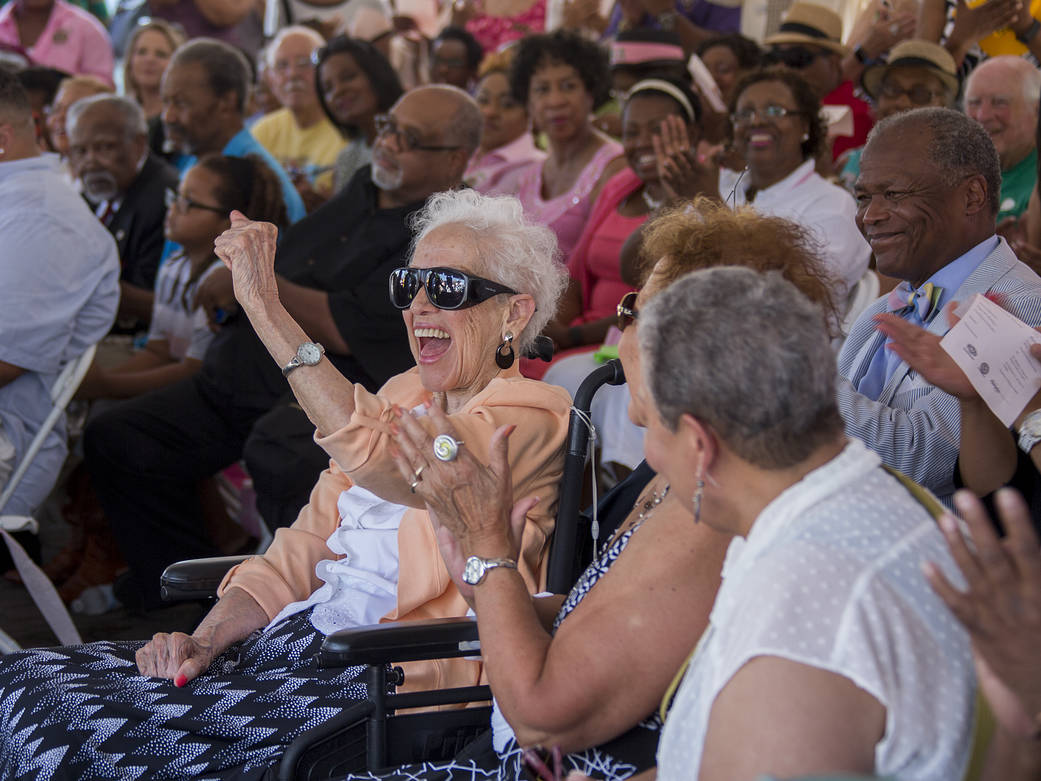庆祝凯瑟琳·约翰逊的一生和事业
Katherine Johnson passed away Feb. 24, 2020, after living a life filled with trail-blazing achievements. Being handpicked to be one of three black students to integrate West Virginia’s graduate schools is something that many people would consider one of their life’s most notable moments, but it’s just one of the breakthroughs that have marked Katherine Johnson’s long and remarkable life. Born in White Sulphur Springs, West Virginia, by thirteen, she was attending the high school on the campus of historically black West Virginia State College. At eighteen, she enrolled in the college itself, graduated with highest honors in 1937 and took a job teaching at a black public school in Virginia.
In 1953, Johnson began working in the all-black West Area Computing section at the National Advisory Committee for Aeronautics’ (NACA’s) Langley laboratory. Just two weeks into her tenure in the office, she was assigned her to a project in the Maneuver Loads Branch of the Flight Research Division, and Katherine’s temporary position soon became permanent.
In 1957, Johnson provided some of the math for the 1958 document Notes on Space Technology, a compendium of a series of lectures given by engineers in the Flight Research Division and the Pilotless Aircraft Research Division (PARD). Engineers from those groups formed the core of the Space Task Group, the NACA’s first official foray into space travel, and Katherine, who had worked with many of them since coming to Langley, “came along with the program” as the NACA became NASA later that year. She did trajectory analysis for Alan Shepard’s May 1961 mission Freedom 7, America’s first human spaceflight. In 1960, she and engineer Ted Skopinski coauthored Determination of Azimuth Angle at Burnout for Placing a Satellite Over a Selected Earth Position, a report laying out the equations describing an orbital spaceflight in which the landing position of the spacecraft is specified. It was the first time a woman in the Flight Research Division had received credit as an author of a research report.
In 1962, as NASA prepared for the orbital mission of John Glenn, Katherine Johnson was called upon to do the work that she would become most known for. The complexity of the orbital flight had required the construction of a worldwide communications network, linking tracking stations around the world to IBM computers in Washington, DC, Cape Canaveral, and Bermuda. The computers had been programmed with the orbital equations that would control the trajectory of the capsule in Glenn’s Friendship 7 mission, from blast off to splashdown, but the astronauts were wary of putting their lives in the care of the electronic calculating machines, which were prone to hiccups and blackouts. As a part of the preflight checklist, Glenn asked engineers to “get the girl”—Katherine Johnson—to run the same numbers through the same equations that had been programmed into the computer, but by hand, on her desktop mechanical calculating machine. “If she says they’re good,’” Katherine Johnson remembers the astronaut saying, “then I’m ready to go.” Glenn’s flight was a success, and marked a turning point in the competition between the United States and the Soviet Union in space.
In this image, she celebrates her 98th birthday, where a historical marker and bench were unveiled to mark the occasion. The event took place by the Virginia Air and Space Center at NASA Langley’s visitor center.
Image Credit: NASA
凯瑟琳·约翰逊(Katherine Johnson)过着充满开拓性成就的生活,于2020年2月24日去世。被选为整合西弗吉尼亚研究生院的三名黑人学生之一,是许多人认为一生中最值得纪念的时刻之一,但这只是凯瑟琳·约翰逊漫长而非凡的一生中取得的众多突破之一。她出生在西弗吉尼亚州的怀特瑟弗斯普林斯,就读于历史悠久的黑人西弗吉尼亚州立大学的一所高中。18岁时,她进入了这所大学,1937年以最高荣誉毕业,并在弗吉尼亚州的一所黑人公立学校任教。
1953年,约翰逊开始在美国国家航空咨询委员会(NACA)兰利实验室的全黑西部地区计算机部门工作。在办公室任职仅两周时间,她就被分配到了飞行研究部机动负荷分部的一个项目中,而凯瑟琳的临时职位很快就成为永久职位。
1957年,约翰逊为1958年的《空间技术笔记》(Notes on Space Technology)提供了一些数学知识,这是飞行研究部和无人飞机研究部(PARD)的工程师们进行的一系列演讲的纲要。来自这些组织的工程师组成了美国国家航空航天局太空任务组的核心,这是美国国家航空航天局首次正式涉足太空旅行。凯瑟琳自从来到兰利后,就和他们中的许多人一起工作。她为艾伦·谢泼德1961年5月的美国第一次载人航天飞行“自由7号”(Freedom 7)做过轨道分析。1960年,她和工程师特德·斯科平斯基(Ted Skopinski)合著了《确定将卫星放置在选定地球位置上的职业倦怠时的方位角的确定》,这份报告列出了描述轨道飞行的方程式,其中指定了航天器的着陆位置。这是飞行研究部门的女性第一次获得研究报告作者的荣誉。
1962年,当NASA为约翰·格伦(John Glenn)的轨道飞行任务做准备时,凯瑟琳·约翰逊(Katherine Johnson)被叫去做一项工作,而这项工作后来成为她最出名的工作。轨道飞行的复杂性要求建立一个全球通信网络,将世界各地的跟踪站与位于华盛顿特区、卡纳维拉尔角和百慕大的IBM计算机连接起来。在格伦的“友谊7号”任务中,电脑上已经编写了轨道方程式,可以控制太空舱从发射到溅落的轨迹,但宇航员们对把自己的生命交给电子计算机很谨慎,因为电子计算机很容易打嗝和断电。作为飞行前检查清单的一部分,格伦要求工程师们“让那个女孩”——凯瑟琳·约翰逊——在她的台式机械计算机上用同样的公式计算同样的数字。“如果她说他们很好,”凯瑟琳约翰逊记得宇航员说,“那么我准备好了。格伦的飞行是成功的,标志着美国和苏联太空竞赛的一个转折点。
在这张照片中,她庆祝自己的98岁生日,并揭开了一个历史性的标记和长凳以纪念这一场合。这项活动是由美国宇航局兰里访客中心的弗吉尼亚航空航天中心举行的。
图片来源:NASA







